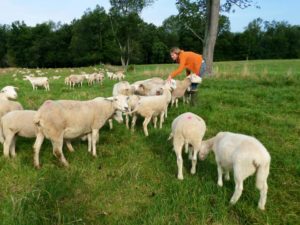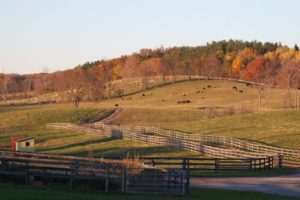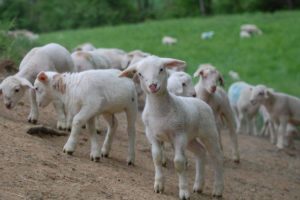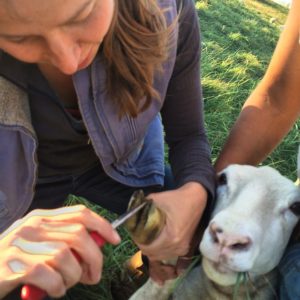Kinderhook Farm: Sheep of Leisure Flock Together
April 6, 2015/
by Angelique Pinet
Anna Hodson is the shepherd at Kinderhook Farm in Valatie, NY, located on over 1,000 acres of rolling pastures at the heart of the fertile Hudson Valley. When she and her husband moved to the farm in 2009, there were only about 20 Dorper ewes—now she tends to a flock of over 400. Anna spoke with Small Farm Quarterly about what she’s learned since becoming a full time employee on a diversified farm; the problem-solving strategies, marketing techniques and principles that have contributed to Kinderhook’s consistent growth over the years; and why you should meet her friendly sheep.
SFQ: What are the most valuable things you have learned since working on the farm?
Hodson: You can’t control anything. Farming teaches you that you can do the best you can, but ultimately you can’t control weather and you can’t control animal health.
SFQ: What are your agricultural goals?
Hodson: For me personally, it’s very important that animals are raised well and with respect. I will not buy or eat meat if I’m not sure where it comes from—I do not want to support meat that hasn’t been well raised. In addition to animal welfare, my goals are effective land use, sustainable practices, and producing good food that feeds the world.
SFQ: What advice would you give to people who want to get into farming?
Hodson: Farming is not an occupation. It’s a lifestyle. You’ve got to love it, and you have to dedicate your life to it essentially. With animals, it’s pretty intense and it’s more than a full time occupation because you can’t leave them easily through the winter. You have to be happy to get up early in the morning and work long hours.
SFQ: What is the farm’s mission?
Hodson: The farm has multiple aims. Owners Steve and Renee Clearman and Lee and Georgia Ranney want a farm that is sustainable and that keeps the land open. Transparency of food producing is one thing everyone at Kinderhook holds very dear. People are very much welcome to the farm. We’re excited to share what we do at the farm and are happy to talk about where the food comes from.
SFQ: What would you say the cornerstone of Kinderhook’s success is?
Hodson: We are really committed to doing what we do and everyone that works here works like a dog because they really believe in what they’re doing. We want to make it work and we all feel very passionate about the animals we raise.
We also learn from our customers. We used to sell our lambs a lot smaller (40-50 lbs. hanging) and our customers told us that they wanted a heavier carcass with more finish (more fat cover), so now we sell them 50-55 lbs. as a standard. We have a very good relationship with the slaughterhouse, butcher shops and restaurants. They show us what they’re looking for and it informs the decisions we make as farmers. We’ve had butchers come look at the animals, we’ve chosen animals with them to send to slaughter and then went to look at them at the slaughterhouse where we compared them to when they were alive. A lot of farmers don’t get to see this part of the process.
SFQ: What marketing techniques have worked best for the farm?
Hodson: Transparency and relationships are our strongest marketing strategies. Conventional things like advertising may have had some impact in the beginning, but now it’s all about relationships. A lot of it has been word of mouth and by having our meat in restaurants and butcher shops. That’s a major part of our marketing, but it’s not something we promote.
We have a close relationship with customers at the farm store as well. When they come to the farm, we don’t just serve them meat; we show them around the farm, introduce them to the animals, talk about the animals, and let them herd the sheep or do whatever we’re doing. People really engage with that and it’s probably one of the most effective marketing strategies we have.
Georgia is the social media guru for the farm. She takes photos of the animals, so [people] get to know them and their personalities. There’s no smoke or mirrors here. These chickens are out on pasture every day and you see how they’re being managed. That’s very reassuring for people who are worried about animal welfare and how they’re being raised.
SFQ: What have been valuable resources of information for you?
Hodson: I go to the Cornell sheep and goat symposium every year, attend NOFA conferences, shepherding courses, anything interesting and relevant. One of the best ways to learn is to meet other farmers and see how they graze and work with their animals. There are a lot of people with a lot of experience.
SFQ: What are some of your strategies for improving soil and plant health?
Hodson: The managed grazing we do is a major strategy. In the winter, we roll out hay in different pastures for the cattle and keep them in different groups depending on sex, age, cow calves, type of animals and finishing groups so we can target feed needs to different animal groups. The tractor rolls the hay bail out behind it and the cattle will pick through the feed. What they don’t eat will cover the ground with organic matter and reseed and rejuvenate the pasture.
Also, after the cattle have been in a winter pasture we sometimes plant annual crops. The cattle will beat the pasture down, then we deliver all that manure, then it gets a covering of hay and then we put seeds down. The hay covers the soil, prevents erosion and helps to reseed. We get high quality forage from this process.
Another strategy is that we clean out the sheep barn once a year and put it back on the hay fields. It’s a deep bed pack. We put hay in the barn for bedding, lambs spend the night in there and deposit on it, and then we put more hay on top.
SFQ: What does a typical day for a shepherd look like? What tasks are done?
Hodson: It depends on the time of year. No matter what time of day, first thing, we check the sheep. We go to wherever they are and walk through them to make sure everyone is okay and no one is sick. Then we check their water to make sure it’s flowing and clean.
You have to go out every day and look at the grass and see where the animals are. Do they need to move today? Do they have to move tomorrow? Look at the grass and determine where they will be in two weeks time. Is the grass coming back sufficiently? How will we graze the sheep around the farm and with the cattle? There are a lot of moving parts.
In summer, they graze during the grass-growing months. In winter, we feed them hay and alfalfa baleage that we make on the farm. Baleage can be various types of forage crops (grass, clover, alfalfa, etc.) that are cut, and dried to about 50% moisture, then bailed and wrapped in plastic where it’s then preserved in air-tight conditions. The result is a higher quality feed.
SFQ: What do you want people to know about sheep that they probably don’t know?
I love my sheep! I want everybody to know how joyful sheep are. I want people to meet my friendly sheep, watch them play and interact with them. They evolved to a very specific way of living and evolved with humans. It’s a codependent relationship and I want people to see that.
Angelique Pinet is a professional writer and beginner organic food grower from New England. She can be reached at angelique.pinet@gmail.com.
Posted in Livestock & Dairy





